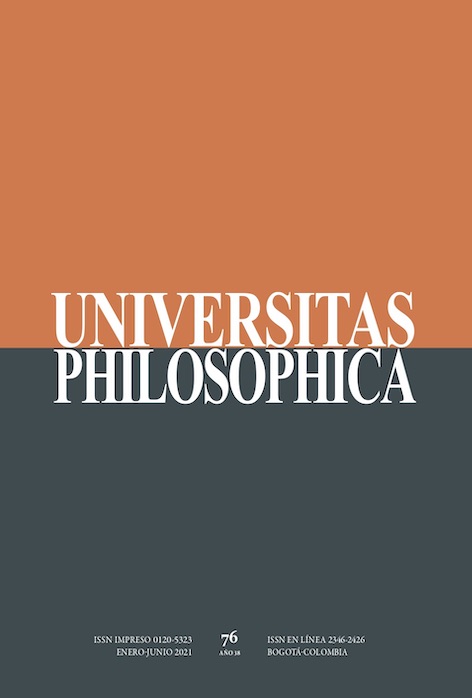Resumen
Este artículo aborda un estudio metafísico sobre límites en la discusión sobre composición material. Según la tesis nihilista, dos o más objetos nunca componen otro objeto. Los objetos materiales ordinarios y sus límites (superficies) serían entidades fiat, mientras que los objetos simples (sin partes) y sus límites precisos son los únicos componentes bona fide del mundo. Sin embargo, si hay razones para postular la existencia de un límite bona fide que separa una colección de objetos de sus alrededores espaciales, entonces tenemos razones para postular también la existencia de un objeto compuesto bona fide. Si existe un límite, dada su dependencia ontológica, debe existir un objeto al cual pertenece. La emergencia de un límite de un objeto material tridimensional instancia propiedades irreductibles a las propiedades de alguna de sus partes. No obstante, una vez que los límites son introducidos en el mundo, la presencia de vaguedad ontológica en términos modales resulta inevitable.
Akiba, K. (2000). Vagueness as a Modality. The Philosophical Quaterly, 50(200), 359-370. https://doi.org/10.1111/j.0031-8094.2000.00191.x
Akiba, K. (2004). Vagueness in the World. Nous 38(3), pp. 407-429. https://www.jstor.org/stable/3506246
Aristóteles. (2007). Metafísica. (Trad. T. Calvo Martínez). Madrid: Gredos.
Barnes, E. (2010). Ontic Vagueness: A Guide for the Perplexed. Nous, 44(4), pp. 601-627. https://www.jstor.org/stable/40959694
Brentano, F. (2010). Philosophical Investigations on Space, Time and the Continuum. (Trad. Barry Smith). New York: Routledge.
Casati, R. & Varzi, A. (1999). Parts and Places: The Structure of Spatial Representation. Cambridge, Massachusetts: MIT Press.
Chisholm, R. (1976). Person and Object: A Metaphysical Study. Chicago: Open Court Publishing Company.
Dummett, M. (1999). Wang’s Paradox. En: R. Keefe & P. Smith (Eds.), Vagueness: A Reader (pp. 99-118). Cambridge: MIT Press.
Euclid (1962). The Thirteen Books of Euclid’s Elements. (Trad. T. L. Heath). Cambridge: Cambridge University Press.
Frege, G. (2007). The Foundations of Arithmetic. (Trad. D. Jacquette). New York: Pearson Longman.
Gourney, J. (2019, 12 de agosto). The Fadeaway Girl and the Kanizsa. Gurney Journey. [Blog post]. Recuperado el 17 de marzo 2021 de http://gurneyjourney.blogspot.com/2019/08/the-fadeaway-girl-and-kanizsa-triangle.html
Heller, M. (1996). Against Metaphysical Vagueness. Nous, 30(10), 177-185. https://doi.org/10.2307/2216242
Heller, M. (2008). The Ontology of Physical Objects: Four-Dimensional Hunks of Matter. Cambridge: Cambridge University Press.
Hirsch, E. (1982). The Concept of Identity. Oxford: Oxford University Press.
Holdich, T. (1916). Political Frontiers and Boundary Making. London: MacMillan.
van Inwagen, P. (1990). Material Beings. London: Cornell University Press.
Jupiter’s Great Red Spot Could Disappear Within 20 Years (2020). Reddit. Recuperado el 17 de marzo 2021 de https://www.reddit.com/r/spaceporn/duplicates/eg0wsn/jupiters_great_red_spot_could_disappear_within_20/
Keefe, R., & Smith, P. (1999). Introduction: Theories of Vagueness. En: R. Keefe & P. Smith (Eds.), Vagueness: A Reader (pp. 99-118). Cambridge: MIT Press.
Keil, G. (2013). Introduction: Vagueness and Ontology. Int Ontology Metaphysics, 14, 149-164. https://doi.org/10.1007/s12133-013-0118-1
Köhler, W. (1947). Gestalt Psychology: The Definitive Statement of the Gestalt Theory. New York: Liveright Publishing Corporation.
Lewis, D. (1986). On the Plurality of Worlds. Oxford: Blackwell.
Merricks (2001). Objects and Persons. Oxford: Oxford University Press.
Núñez, G. (2019). Boundaries and Things: A Metaphysical Study of the Brentano-Chisholm Theory. Kriterion, 33(2), 15-47.
Parret, T. (2014, 15 de mayo). Swarm and Fuzzy. Newsweek. Recuperado el 17 de marzo 2021 de https://www.newsweek.com/2014/05/23/swarm-and-fuzzy-251115.html
Rosen, G., & Dorr, C. (2002). Composition as a Fiction. En: R. Gale (Ed.), The Blackwell Guide to Metaphysics (pp. 151-174). Oxford: Blackwell.
Russell, B. (1999). Vagueness. En: R. Keefe & P. Smith (Eds.), Vagueness: A Reader (pp. 61-68). Cambridge: MIT Press.
Sainsbury, R. M. (1989). What is a Vague Object? Analysis, 49(3), 99-103. https://doi.org/10.1093/analys/49.3.99
Schaffer, J. (2009). Spacetime the One Substance. Philosophical Studies: An International Journal for Philosophy in the Analytic Tradition, 145(1), 131-148. https://doi.org/10.1007/s11098-009-9386-6
Smith, B. (1995). On Drawing Lines on a Map. En: A. U. Frank, W. Kuhn & D. M. Mark (Eds.), Spatial Information Theory. Proceedings of the Third Conference - COSIT’1995 (pp. 475-484). Berlin: Springer-Verlag.
Smith, B. (2001). Fiat Objects. Topoi, 20(2), 131-148. https://doi.org/10.1023/A:1017948522031
Smith & Varzi (2000). Fiat and Bona Fide Boundaries. Philosophy and Phenomenological Research, 60(2), 401-420.
Sorensen, R. (1998). Transitions. Philosophical Studies: An International Journal for Philosophy in the Analytic Tradition, 91(3), 275-295. https://doi.org/10.1007/BF00354587
Stroll, A. (1988). Surfaces. Minneapolis: University of Minnesota Press.
Tye, M. (1990). Vague Objects. Mind, 99(396), 535-557. https://doi.org/10.1093/mind/XCIX.396.535
Varzi, A. (2001). Vagueness in Geography. Philosophy and Geography, 4(1),
-65.
Varzi, A. (2011). Boundaries, Conventions, and Realism. En: J. Kleim & M. O’Rourke (Eds.), Carving Nature at its Joints. Cambridge: MIT Press.

Esta obra está bajo una licencia internacional Creative Commons Atribución 4.0.
Derechos de autor 2021 Gonzalo Germán Nuñez Erices


